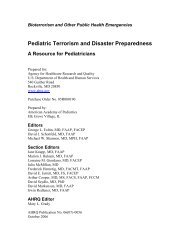(HPP) Performance Measure Manual
(HPP) Performance Measure Manual
(HPP) Performance Measure Manual
You also want an ePaper? Increase the reach of your titles
YUMPU automatically turns print PDFs into web optimized ePapers that Google loves.
APPENDIX A<br />
a coordinated response among various jurisdictions and functional agencies, both public and private, and<br />
establishes common processes for planning and managing resources (http://www.fema.gov/incidentcommand-system#item1).<br />
Immediate Bed Availability (IBA): IBA is the concept whereby coalition partners provide an appropriate<br />
level of care to patients (non-disaster and disaster-related patients) during declared disasters with public<br />
health implications, by availing 20% of staffed hospital beds to higher acuity patients within four (4)<br />
hours of a disaster and identifying and providing the appropriate care for lower acuity patients.<br />
Information Sharing: The ability to conduct multijurisdictional and multidisciplinary exchange of public<br />
health and medical-related information and situational awareness data among Federal, State, local,<br />
territorial, and tribal levels of government and the private sector. This capability includes the routine<br />
sharing of information as well as issuing of public health alerts to Federal, State, local, territorial, and<br />
tribal levels of government and the private sector in preparation for, and in response to, events or<br />
incidents of public health significance. An effective information sharing system will provide durable,<br />
reliable, and effective information exchanges (both horizontally and vertically) between those<br />
responsible for gathering information and the analysts and consumers of threat or hazard-related<br />
information. It will also allow for feedback and other necessary communications in addition to the regular<br />
flow of information and intelligence.<br />
Interagency Agreement (IAA): A written agreement between Federal agencies or components of Federal<br />
agencies to acquire supplies or services as authorized by statute.<br />
Key Partners: Within the context of Fatality Management, private organizations that have agreed to play<br />
a role in performing Fatality Management functions, such as funeral directors, coroners, medical<br />
examiners, or mental health professionals.<br />
Medical Surge: The ability to provide adequate medical evaluation and care during events that exceed<br />
the limits of the normal medical infrastructure of an affected community. It encompasses the ability of<br />
the healthcare service delivery system to survive a hazard impact and maintain or rapidly recover<br />
operations that were compromised.<br />
Memoranda of Understanding (MOUs) or Memoranda of Agreement (MOAs): Documents that describe<br />
a bilateral or multilateral agreement between two or more parties. These documents express an<br />
intended common line of action, establish a scope of association, and define mutual responsibilities. They<br />
are often used in cases where parties do not wish to or cannot create an otherwise legally enforceable<br />
agreement.<br />
Mental or Behavioral Health Professional: Someone who offers services that have the effect of<br />
improving an individual's mental state, such as psychologists, social workers, therapists, counselors,<br />
spiritual care providers, hospice providers, and translators, or embassy and Consulate representatives<br />
when international victims are involved.<br />
Mutual Aid Agreements (MAAs): A document that formalizes and defines the reciprocal assistance that<br />
two or more communities or organizations can and will provide to another in the event of a disaster.<br />
Personal Protective Equipment (PPE): Specialized clothing or equipment worn by an employee for<br />
protection against infectious materials. PPE such as masks and gloves can protect healthcare workers<br />
from illness and injury allowing them to continue delivering important healthcare services. Ensuring a<br />
sufficient supply of PPE requires a number of steps be taken during emergency preparedness including:<br />
determining the PPE need, assessing in-facility stocks of PPE, comparing need and stock to identify any<br />
PPE gaps, and then developing procedures for obtaining the gap amount should you need it (e.g., a<br />
resource request via the ICS resource management system).<br />
Hospital Preparedness Program (<strong>HPP</strong>) <strong>Performance</strong> <strong>Measure</strong> <strong>Manual</strong><br />
Guidance for Using the New <strong>HPP</strong> <strong>Performance</strong> <strong>Measure</strong>s Page | 59
















